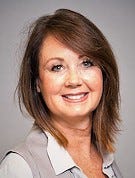Rackspace Channel Execs: TSBs, Agents Key to Managed Cloud GrowthRackspace Channel Execs: TSBs, Agents Key to Managed Cloud Growth
Renee Taylor and Vicki Patten sat down with Channel Futures on Wednesday for some one-on-one time.

CHANNEL PARTNERS CONFERENCE & EXPO, LAS VEGAS — Managed cloud computing and IT services provider Rackspace Technology is homing in on technology solutions brokerages and their agents.
The company, essentially a large managed service provider akin to Accenture or Deloitte, has attended the annual Channel Partners Conference & Expo for at least the last five years. This year, Rackspace came to the show with new channel leaders at the helm: Renee Taylor and Vicki Patten. They succeeded Lisa McLin and Michael Stephens, respectively.
Taylor, who joined Rackspace last November from Capgemini, is now vice president of global alliances and channel chief. Patten has worked for Rackspace since 2017. She holds the title of agent channel chief/director of channel sales. In those new roles, Taylor and Patten have a lot of growth plans on their plates. And they are optimistic.

Rackspace’s Vicki Patten
“We’ve developed deeper relationships with the right [TSBs and] agents,” Patten told Channel Futures onsite at the world’s largest independent channel event.
These partners, while always not cloud-centric or cloud-native, are keen to have managed cloud computing in their portfolios. Rackspace, meantime, wants to deliver associated professional services – think cloud cost optimization and management, multi- and public cloud management, and more – to those partners’ clients.
“It used to be more figuring out who’s who,” Patten said. “Now we know. And particularly at Channel Partners, it’s about getting executive leaders together” and helping them craft their cloud practices.
“We’re more strategic about who we’re meeting and talking with,” Patten added.
A key part of that is zeroing in on specific managed cloud and other IT outcomes that Rackspace and its partners can achieve for end users.
“We want to focus on certain areas,” Taylor said.
For example, Rackspace is teaming with Armor, Akamai and Cloudflare on security initiatives. But Rackspace is looking to expand — think retail, as one instance, or whatever might best need customer needs. It’s all about identifying “that area where we can really grow together,” Taylor said.
Understanding Rackspace’s Channel Position
As such, it’s important to understand Rackspace’s position within the channel. It’s sort of a mix of vendor and partner itself, which can prove off-putting to small MSPs who fear the company might want to take their business.
That’s not the case, Taylor and Patten assured Channel Futures; yet, that’s also why targeting agents with managed cloud services makes the most sense for Rackspace. In this scenario (and same applies for the few IT-centric MSPs and resellers with which Rackspace does work), Rackspace works alongside agents to help customers.
“It’s a sell-with and sell-through” model, as Patten explained.
From there, Rackspace pays those partners monthly recurring revenue for referrals and renewals.
“We are the largest lead-generation organization within Rackspace,” Patten said.
Taylor agreed.
“Thirty-five percent of leads come through the channel,” she said. “We’re expected to contribute at least 25%. We’re seeing 30-35% in the Americas.”
And that figure translates into 75% of Rackspace’s overall business, Taylor noted.
Rackspace intends to keep the growth going. To support that goal, Taylor and Patten will make some workloads easier for partners to navigate. Rackspace, after all, is a giant corporation, with around 7,000 employees and more than $3 billion in 2021 revenue. That size of company tends to come with a lot of bureaucracy and red tape. Taylor and Patten aim to reduce some of that burden for their channel partners.

Rackspace’s Renee Taylor
“We’re improving our processes, making it easier to do business with us,” Taylor said. That encompasses partner portals and commissions, “everything the channel team is focused on.”
Rackspace even has added field marketing for more clear, co-branded channel messaging, and Taylor wants to expand the number of personnel to include more regional experts who will interface with partners.
“We’ve needed more hands-on [people],” she said. “I’m trying to expand the program because I want to double down. This is working.”
Some Things Will Change, But Not Everything
Even with upcoming changes, and with high-level channel personnel changes in the recent past, Patten wants to make sure partners know: “The main thing is the team is mostly the same.”
Taylor again agreed.
“The team hasn’t changed that much and I was able to promote from within. … We have a very stable team … which has been great.”
Overall, though, don’t look for Taylor and Patten to do anything that would rock the channel boat.
“We just want to keep the growth pattern,” Patten said. “We don’t want to change too much to interrupt growth.”
Want to contact the author directly about this story? Have ideas for a follow-up article? Email Kelly Teal or connect with her on LinkedIn. |
About the Author
You May Also Like


